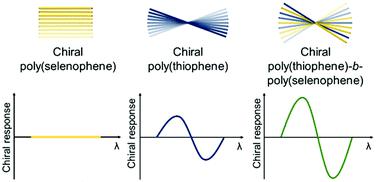当前位置:
X-MOL 学术
›
Polym. Chem.
›
论文详情
Our official English website, www.x-mol.net, welcomes your feedback! (Note: you will need to create a separate account there.)
Chiral expression of co-crystallizing poly(thiophene)-block-poly(selenophene) copolymers
Polymer Chemistry ( IF 4.6 ) Pub Date : 2020-03-18 , DOI: 10.1039/c9py01775e Birgitt Timmermans 1, 2, 3, 4 , Guy Koeckelberghs 1, 2, 3, 4
Polymer Chemistry ( IF 4.6 ) Pub Date : 2020-03-18 , DOI: 10.1039/c9py01775e Birgitt Timmermans 1, 2, 3, 4 , Guy Koeckelberghs 1, 2, 3, 4
Affiliation

|
In this report, the chiral expression of co-crystallizing conjugated poly(thiophene)-b-poly(selenophene) copolymers is investigated. For this purpose, different poly(thiophene)-b-poly(selenophene) copolymers were synthesized via controlled Kumada catalyst transfer condensative polymerization (KCTCP). The homopolymers, poly(thiophene) and poly(selenophene), are synthesized as a reference. Solvatochromism experiments were conducted to investigate the (chiral) self-assembly of all the polymers using UV-vis and circular dichroism (CD) spectroscopy. It was found that, although the chiral homopoly(selenophene) surprisingly did not self-assemble in a chiral way, the block copolymers did show a chiral expression. This can only be explained by the suggested co-crystallization of the block copolymers, since for (micro)phase-separating block copolymers no chiral expression would be expected, as the first aggregating block, in this case the poly(selenophene) block, then would dictate its stacking to the second block. Differential scanning calorimetry (DSC) further suggested the co-crystallization of the block copolymers. Moreover, the chiral expression of the poly(thiophene)-b-poly(selenophene) copolymers was even larger than for the homopoly(thiophene), which can be explained by the increased disorder present in the block copolymers. Dynamic light scattering (DLS) eliminated the existence of a correlation between the chiral response and the size of the polymer aggregates, further evidencing that the increase in the chiral response of the block copolymers is solely due to the suggested co-crystallization of the block copolymers.
中文翻译:

共结晶聚(噻吩)-嵌段-聚(硒烯)共聚物的手性表达
在该报告中,研究了共结晶共轭聚(噻吩)-b-聚(硒烯)共聚物的手性表达。为此,通过以下方法合成了不同的聚(噻吩)-b-聚(硒烯)共聚物控制的熊田催化剂转移缩聚(KCTCP)。合成均聚物聚噻吩和聚硒烯作为参考。进行了溶剂变色实验,以使用紫外可见光谱和圆二色性(CD)光谱研究所有聚合物的(手性)自组装。已经发现,尽管手性均聚(硒烯)出人意料地没有以手性方式自组装,但是嵌段共聚物确实显示出手性表达。这只能通过建议的嵌段共聚物的共结晶来解释,因为对于(微)相分离的嵌段共聚物,没有手性的表现,作为第一个聚集嵌段,在这种情况下是聚(硒烯)嵌段,将指示其堆叠到第二个块。差示扫描量热法(DSC)进一步表明嵌段共聚物的共结晶。此外,聚噻吩的手性表达b-聚(硒吩)共聚物甚至比均聚(噻吩)共聚物大,这可以通过嵌段共聚物中存在的无序增加来解释。动态光散射(DLS)消除了手性反应与聚合物聚集体尺寸之间的相关性,进一步证明了嵌段共聚物的手性反应的增加仅归因于建议的嵌段共聚物的共结晶。
更新日期:2020-04-24
中文翻译:

共结晶聚(噻吩)-嵌段-聚(硒烯)共聚物的手性表达
在该报告中,研究了共结晶共轭聚(噻吩)-b-聚(硒烯)共聚物的手性表达。为此,通过以下方法合成了不同的聚(噻吩)-b-聚(硒烯)共聚物控制的熊田催化剂转移缩聚(KCTCP)。合成均聚物聚噻吩和聚硒烯作为参考。进行了溶剂变色实验,以使用紫外可见光谱和圆二色性(CD)光谱研究所有聚合物的(手性)自组装。已经发现,尽管手性均聚(硒烯)出人意料地没有以手性方式自组装,但是嵌段共聚物确实显示出手性表达。这只能通过建议的嵌段共聚物的共结晶来解释,因为对于(微)相分离的嵌段共聚物,没有手性的表现,作为第一个聚集嵌段,在这种情况下是聚(硒烯)嵌段,将指示其堆叠到第二个块。差示扫描量热法(DSC)进一步表明嵌段共聚物的共结晶。此外,聚噻吩的手性表达b-聚(硒吩)共聚物甚至比均聚(噻吩)共聚物大,这可以通过嵌段共聚物中存在的无序增加来解释。动态光散射(DLS)消除了手性反应与聚合物聚集体尺寸之间的相关性,进一步证明了嵌段共聚物的手性反应的增加仅归因于建议的嵌段共聚物的共结晶。



























 京公网安备 11010802027423号
京公网安备 11010802027423号